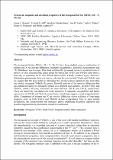Structural, magnetic and electrical properties of the hexagonal ferrites MFeO3 (M=Y, Yb, In)
Abstract
The hexagonal ferrites MFeO3 (M=Y, Yb, In) have been studied using a combination of neutron and X-ray powder diffraction, magnetic susceptibility, dielectric measurements and 57Fe Mössbauer spectroscopy. This study confirms the previously reported crystal structure of InFeO3 (YAlO3 structure type, space group P63/mmc), but YFeO3 and YbFeO3 both show a lowering of symmetry to at most P63cm (ferrielectric YMnO3 structure type). However, Mössbauer spectroscopy shows at least two distinct Fe sites for both YFeO3 and YbFeO3 and we suggest that the best model to rationalise this involves phase separation into more than one similar hexagonal YMnO3-like phase. Rietveld analysis of the neutron diffraction data was carried out using two hexagonal phases as a simplest case scenario. In both YFeO3 and YbFeO3, distinct dielectric anomalies are observed near 130 K and 150 K, respectively. These are tentatively correlated with weak anomalies in magnetic susceptibility and lattice parameters, for YFeO3 and YbFeO3, respectively, which may suggest a weak magnetoelectric effect. Comparison of neutron and X-ray powder diffraction shows evidence of long-range magnetic order in both YFeO3 and YbFeO3 at low temperatures. Due to poor sample crystallinity, the compositional and structural effects underlying the phase separation and possible magnetoelectric phenomena cannot be ascertained.
Citation
Downie , L J , Goff , R J , Kockelmann , W , Forder , S D , Parker , J E , Morrison , F D & Lightfoot , P 2012 , ' Structural, magnetic and electrical properties of the hexagonal ferrites MFeO 3 (M=Y, Yb, In) ' , Journal of Solid State Chemistry , vol. 190 , pp. 52-60 . https://doi.org/10.1016/j.jssc.2012.02.004
Publication
Journal of Solid State Chemistry
Status
Peer reviewed
ISSN
0022-4596Type
Journal article
Description
We thank EPSRC for funding, STFC for providing neutron facilities and Diamond Light Source for provision of synchrotron facilities. We thank Dr Chiu Tang for assistance at Diamond and Dr A. Kusmartseva (University of Edinburgh) for assistance with the SQUID measurements. FDM thanks the Royal Society for a Research Fellowship.Collections
Items in the St Andrews Research Repository are protected by copyright, with all rights reserved, unless otherwise indicated.

